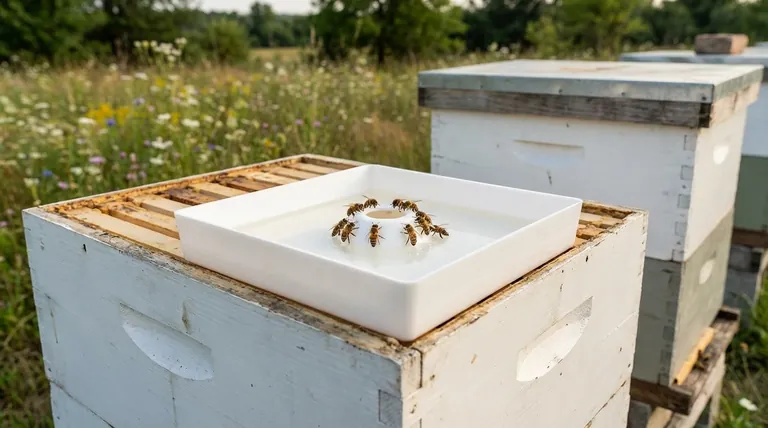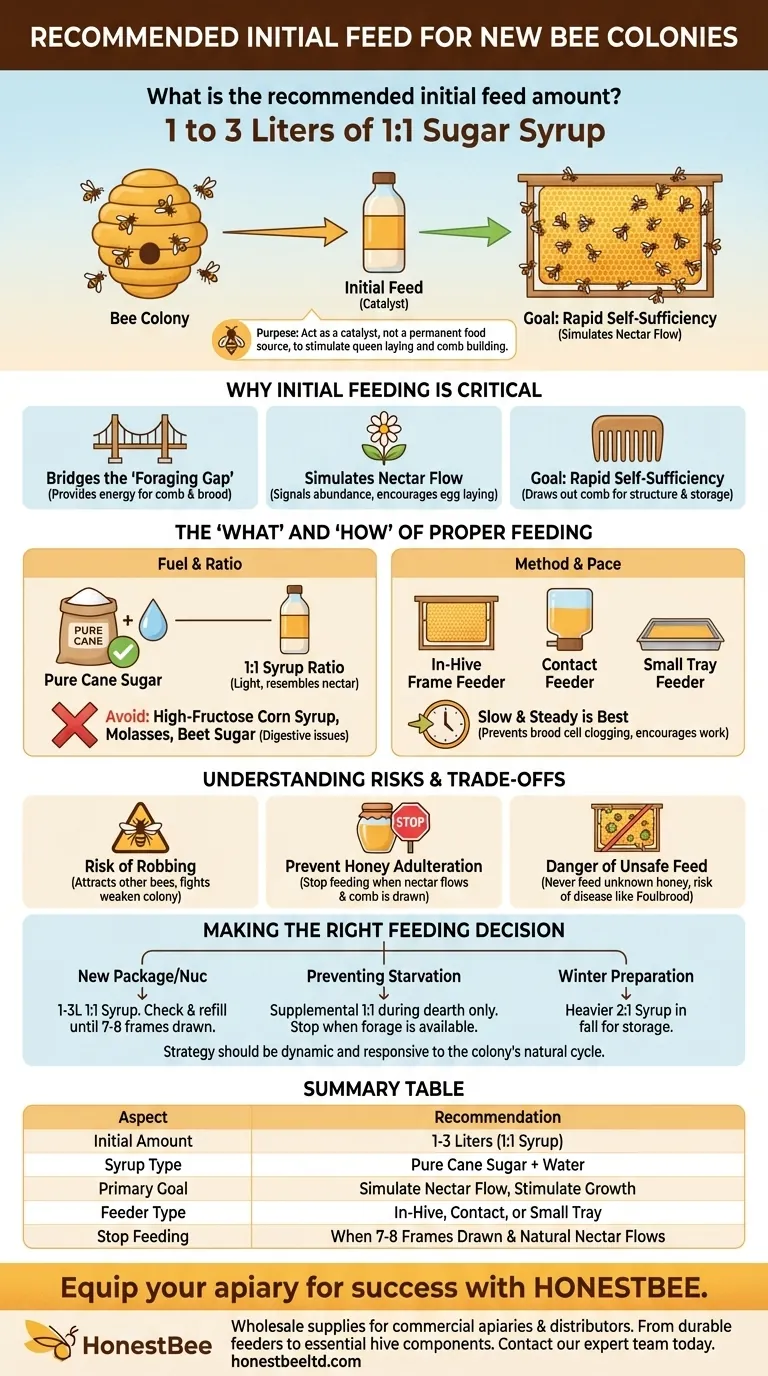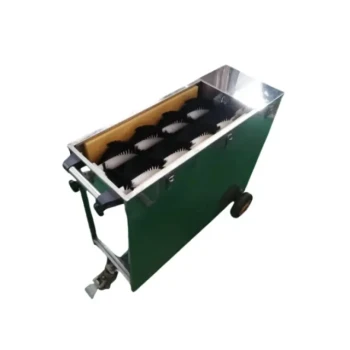For a new bee colony, the recommended initial feed is between 1 to 3 liters of 1:1 sugar syrup. This amount provides immediate energy for critical tasks like comb building and brood rearing without overwhelming a small population. The key is to monitor the colony's consumption rate and adjust your feeding schedule based on how quickly they store or use the syrup.
Your goal is not to be a permanent food source, but to act as a catalyst. The purpose of initial feeding is to simulate a natural nectar flow, stimulating the queen to lay and workers to build, until the colony becomes strong enough to forage for itself.

Why Initial Feeding is Critical for Colony Establishment
Starting a new colony, whether from a package or a nucleus hive, presents a unique challenge. The hive has a small population of foragers and no stored resources. Feeding bridges this crucial gap.
Bridging the "Foraging Gap"
A new colony has an urgent need for carbohydrates to produce wax and feed developing larvae. With few foragers, it cannot gather enough nectar to meet this initial high demand. Supplemental feeding provides this essential energy boost internally.
Simulating a Nectar Flow
A slow, steady supply of sugar syrup mimics a natural nectar flow. This signals to the queen that resources are abundant, encouraging her to begin laying eggs at a high rate, which is vital for building the colony's population.
The Goal: Rapid Self-Sufficiency
The objective of feeding is to get the colony to a state of self-sufficiency as quickly as possible. You are providing the fuel they need to draw out comb on their frames, creating the necessary structure for brood rearing and future honey storage.
The "What" and "How" of Proper Feeding
The success of your feeding strategy depends as much on the type of syrup and delivery method as it does on the amount.
Choosing the Right "Fuel": Pure Cane Sugar
Use only granulated white cane sugar mixed with water. Its primary component, sucrose, is easily broken down by bees' enzymes into the simple sugars they need.
Avoid other sweeteners like high-fructose corn syrup, molasses, or beet sugar. These can contain impurities or complex sugars that bees cannot digest properly, potentially causing dysentery and harming the colony.
The Correct Syrup Ratio: 1-to-1
For stimulating growth in the spring or for a new colony, a 1:1 syrup ratio (by weight or volume) is the standard. This light syrup closely resembles the consistency of natural flower nectar.
Why "Slow and Steady" is Best
Rapidly providing large amounts of syrup can cause the bees to store it in the brood cells, limiting the queen's laying space. Slow feeding encourages them to consume it as they work.
Use a contact feeder, a small tray feeder, or an in-hive frame feeder. These methods minimize drowning risk and control the rate of consumption.
Understanding the Trade-offs and Risks
While necessary, feeding is an intervention that carries risks. A knowledgeable beekeeper understands and mitigates them.
Risk of Robbing
An external food source can attract bees from other hives, leading to "robbing." Robber bees will fight the colony to steal its resources, which can quickly decimate a new, weak hive. Using in-hive feeders helps minimize this risk.
Preventing Honey Adulteration
Never feed sugar syrup when you intend to harvest honey from the hive. You must stop feeding once the bees are actively bringing in natural nectar and have drawn out sufficient comb. This ensures your final honey product is pure and not contaminated with sugar water.
Danger of Unsafe Feed
Never feed a colony honey from an unknown source or from another beekeeper. Honey can carry spores for diseases like American Foulbrood, which can be devastating. Only feed back honey that originated from your own healthy hives.
Making the Right Feeding Decision
Your feeding strategy should be dynamic and responsive to your specific goals and the colony's progress.
- If your primary focus is establishing a new package or nuc: Begin with 1-3 liters of 1:1 syrup, check the feeder every few days, and refill as they consume it until 7-8 frames of comb are drawn in their first hive body.
- If your primary focus is preventing starvation in an established hive: Provide supplemental 1:1 syrup during a nectar dearth only as needed, and stop immediately once natural forage becomes available again.
- If your primary focus is preparing a colony for winter: This requires a different strategy using a heavier 2:1 syrup in the fall, which is intended for storage, not stimulation.
Ultimately, successful feeding is less about a fixed recipe and more about a responsive partnership with your colony's natural cycle.
Summary Table:
| Feeding Aspect | Key Recommendation |
|---|---|
| Initial Amount | 1 to 3 liters of 1:1 sugar syrup |
| Syrup Type | Pure white cane sugar mixed with water |
| Primary Goal | Simulate a nectar flow to stimulate growth |
| Feeder Type | In-hive frame feeder, contact feeder, or small tray feeder |
| Stop Feeding | When 7-8 frames of comb are drawn and natural nectar flow begins |
Equip your apiary for success with HONESTBEE.
Establishing a strong, self-sufficient colony starts with the right resources and knowledge. At HONESTBEE, we supply commercial apiaries and beekeeping equipment distributors with the high-quality, wholesale-focused supplies needed to support healthy hives from day one—from durable feeders to essential hive components.
Let us help you build a thriving operation. Contact our expert team today to discuss your wholesale needs and how we can support your beekeeping success.
Visual Guide

Related Products
- HONESTBEE Professional Hive Top Bee Feeder Feeding Solution
- HONESTBEE Entrance Bee Feeder Professional Hive Nutrition Solution for Beekeeping
- Classic Boardman Entrance Bee Feeder Hive Front Feeding Solution
- HONESTBEE Professional Entrance Bee Feeder Hive Nutrition Solution
- Boardman Entrance Bee Feeder Durable Galvanized Steel and Wood Construction for Beekeeping
People Also Ask
- What are the advantages of hive top feeders? Maximize Feeding Efficiency for Your Apiary
- Why is a top feeder essential for bees? Ensure Colony Health and Efficiency
- How is the plywood floor fitted into the hive-top feeder? Ensure Longevity with a Floating Floor Design
- What safety features are included in top feeders? A Guide to Drowning Prevention and Hive Safety
- What is a top feeder for bees? Maximize Colony Health with Efficient Feeding



















